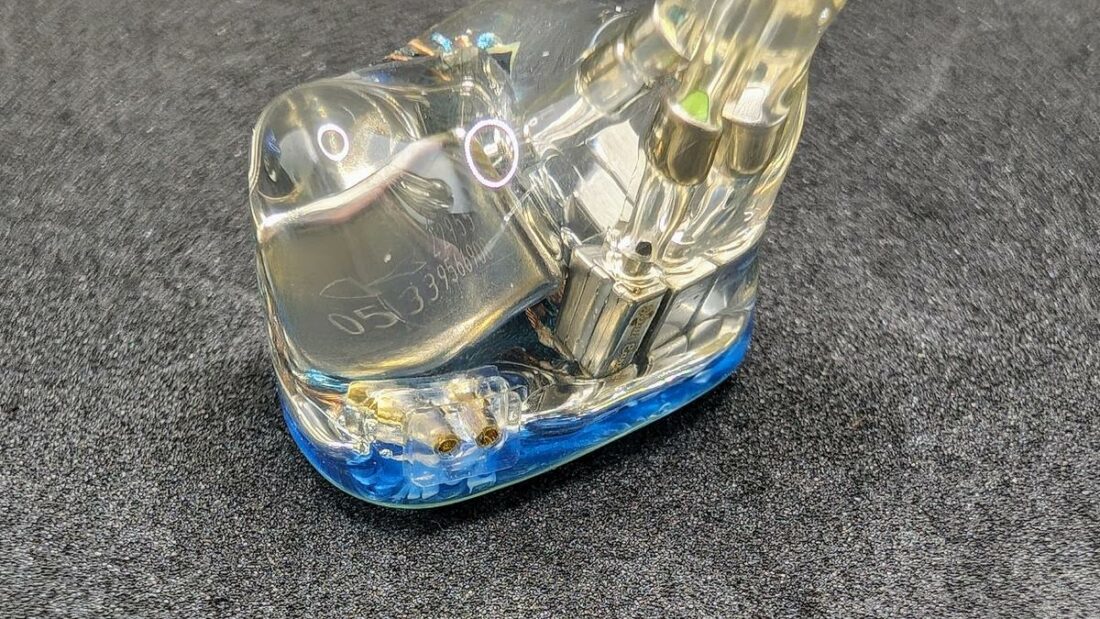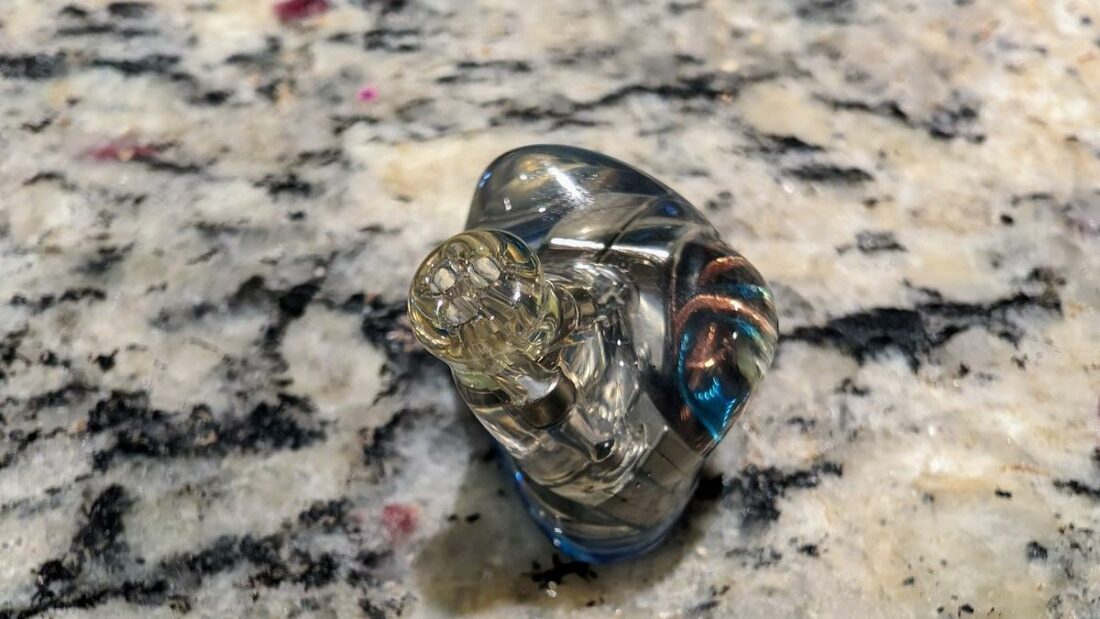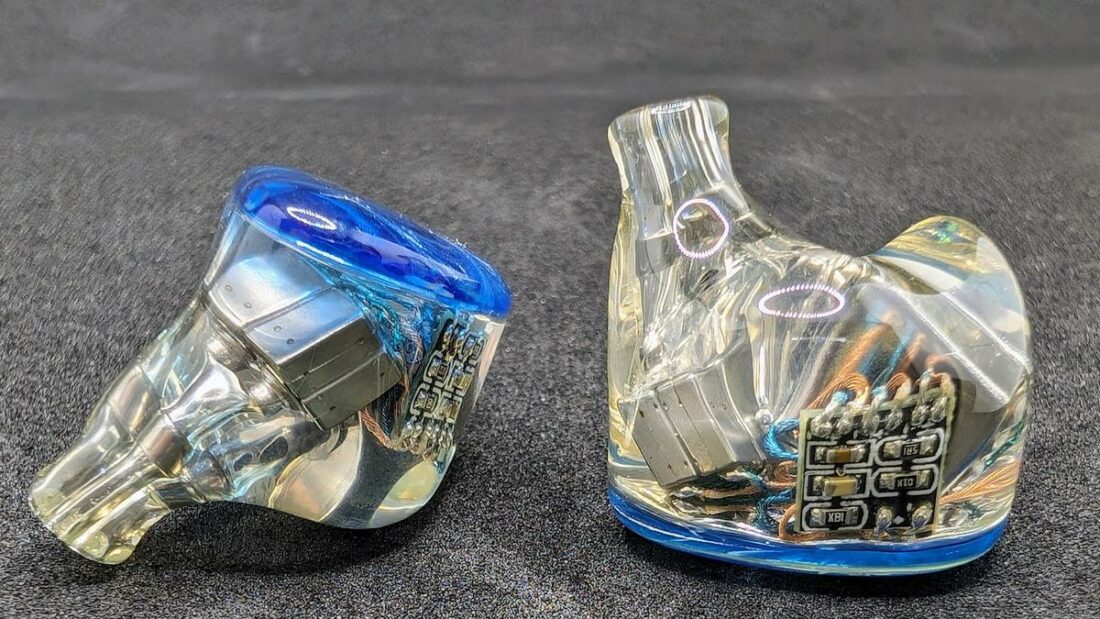‘Lite’ doesn’t mean ‘less than.’
- Attractive, light, and comfortable design
- Excellent fit and finish
- Good complement of accessories
- Neutral-bright tuning with very high resolution and technical capabilities
- For an actual professional audience who will appreciate and use the IEM’s ability to dissect
- Some sharpness and shoutiness become more pronounced and fatiguing at medium-high volumes
- Not a consumer-friendly sound profile
- Exceptional speed and detail can come at the cost of resonance and warmth
- Bass authority and impact are light and unimpressive
- Not for pure “fun” listening or bass aficionados (bassheads, definitely not)

The original Orchestra model was a big success for Kiwi Ears, receiving a great deal of positive attention. The newer Orchestra Lite (hereafter “OL”) was built on the same foundation and redesigned to be more efficient and less expensive.
The OL features the same eight balanced armature driver configuration and tonal balance as their predecessor. In close partnership with the driver manufacturers, Kiwi Ears developed custom balanced armature drivers that deliver a more efficient performance at the same specs.

Unboxing and First Impression
Design and Build
Each OL faceplate is handmade and unique, with the custom Kiwi Ears BA drivers wrapped in transparent medical-grade resin. The blue and green versions are equally mesmerizing in the light.

I love the crystal clear bodies, revealing a perfectly organized use of internal space. This transparency signals to me that Kiwi Ears is entirely confident showing off the OL’s parts and their design/build prowess.
There are zero edges, and the finish is very high quality. They look and feel much more expensive than they are. Each unit undergoes two separate rounds of quality control inspection.

The 2-pin connectors are flush with the body. The cable connectors sit snugly against the body with no gaps. The nozzles reveal the exit of three sound tubes and are collarless. All of the dozen ear tips I tried had no issues holding on.

Cable
The shimmery white 4-core 7n oxygen-free copper (OFC) cable is light and comfortable, aiding the IEMs’ usefulness for stage duty and portable listening. The stock cable comes standard with 2-pin connectors and a 3.5mm plug. Terminations feel well-reinforced and durable. The cable doesn’t tangle, and the chin slider stays wherever I put it.
There are zero microphonics, which is critical for musicians and other audio professionals who perform or actively move around while wearing IEMs.

Comfort
The OL are lightweight, ergonomic, and comfortable enough to forget about them, despite the eight drivers and medium-large body to fit them. The cable ear hooks hold to their shape, are flexible, and do their job well, securing the IEMs in place.
Kiwi Ears includes three sets of diverse silicone tips (all in S, M, and L). Huzzah!
From an ease of listening perspective, Dekoni Bulletz Mercury memory foam tips worked best for me (not included). While they have the added benefits of enhanced comfort and smoothing some treble sharpness, some detail and resolution will be dampened.

Under the Hood
The OL house a total of eight balanced armature drivers in each IEM. There are two custom ultra-tweeters for the treble, four custom midrange drivers for the mids, and two large subwoofer drivers for the lows.


How Do the Kiwi Ears Orchestra Lite Sound?
For evaluation, I listen to a great variety of music through numerous sources, including DAPs (FiiO M15S), phones (LG V20, LG V60), portable DAC/amps (HELM Audio Bolt, DB12 AAAMP, TempoTec Sonata E44, Khadas Tea, Qudelix-5K) and desktop DAC/amps (S.M.S.L SP200, HIFIMAN EF400).
With a very low impedance of 16 ohms and a high sensitivity of 112dB, the OL are easy to drive from any source. Tuning is best described as neutral-bright. A result of the aforementioned three-way passive crossover strategy is an intentional restriction of the sub-bass frequencies, with a peak of 8dB volume from 20Hz to 200Hz.

Kiwi Ears intends the OL IEMs to mimic the sound of professional studio monitors so that professionals will experience a more familiar and consistent sound profile. For performers, this is perfect, as there is no need to duplicate these frequencies in the inner ears when they are felt in the environment.
The soundstage is average and natural, with even-sounding channel balance. Timbre is generally good and reasonably accurate, only compromised by occasional excessive splashiness in the treble and some lack of note weight and resonance for instruments such as drums, cello, and piano.

For this review, I visited the following artists and their home locations:
- Australia: Ember by Plini
- Spain (Barcelona): Incantation by Trobar de Morte
- United States: Cake Batter by Chronologist
- Faroe Islands, Netherlands: Salt by Eivør
A fascinating collection from several continents, these diverse musical productions range in ethnic origins, musical styles, and explorations in audio.
Bass
The OL do not feel or sound lite in any way except for the intentional bass restriction. As the frequency response graph suggests, the bass is well-tuned and balanced. The bass sounds quick and metaphorically light on its feet.
The bass presentation is clean, defined, and polite. The BAs do a good job of rendering quality over quantity.
When music challenges the IEMs to produce low-end grunt, the OL do not deliver.
They lack impact, weight, and authority.
I can hear the bass. I can’t feel the bass. For general listening, it’s not enough to enjoy much of my preferred music to the fullest. For critical listening, the OL are terrific tools.

Midrange
The midrange is both prominent and smooth, with no hint of recession in mixes. Kiwi Ears asserts that the mids region is neutral, with only a 2dB difference from 200Hz to 800Hz to provide an ever-slight hint of warmth without muddying. I agree.

Treble
I suppose with so much detail, you may be able to hear every “nuisance.”
I believe Kiwi Ears meant “nuance,” to which I agree. Clarity and distinction of sounds are the OL’s strengths. To my ears, there is less treble roll-off over 10kHz than the graph indicates. Some users who prefer more ‘air and sparkle’ may notice the deficiency.

The treble will cut through the mix at any volume, a big plus for musicians in live settings where ambient lower frequencies and volume can drown out monitor details. Detail is available at lower volumes, which is very helpful for mixing and production work.
If you are treble-sensitive, the OL will likely be too much or take some getting used to. Despite the spikes, there is not much sibilance. The peaks from approximately 5.5kHz – 8kHz can be evident by shouting and oversharpening specific instruments and effects such as cymbal strikes.
Comparisons
The Kiwi Ears Quintet are a similarly priced model with a completely different hybrid driver configuration. The Quintet are excellent all-around performers with a more consumer-friendly sound signature. The bass frequencies are more prominent and physical than the OL.

The Quintet excel in achieving the rare combination of large soundstage and precise imaging, with exceptional clarity and treble extension in their price range. Based on the complex configuration, hybrid driver combination, sound, and comfort, the Quintet are a sold value and sound much more expensive than they are.
Where to Buy

Who Should Buy This?
Kiwi Ears designed the OL for professionals. I believe the team hit their mark, and in my opinion, they are a great choice at a surprisingly attractive price for their performance. It’s quite a bonus to have such beautiful and beautifully made work tools.
If you prefer IEMs with a brighter signature and excellent technical chops, the OL are a smart choice. This applies as well to detail and treble lovers. The OL are great for fast, technical, complex music and crowded mixes, from Baroque-period classical to speed and thrash metal.
The OL are not for you if you want a distinct, colored, or unique sound signature. If you dig deep grooves, consider Kiwi Ears’ Cadenza or Quartet.

Final Thoughts
What I appreciate the most about the OL is that Kiwi Ears did not attempt to produce an IEM to appeal to the general population of consumers. They stated their intentions clearly and executed the strategy. Well done!
I would have been disappointed if I was not aware of that. I hope that this is helpful for you to keep in mind in deciding if the OL are right for you. Given the low cost for high performance, the OL are impressive and, if used properly, will serve you well.
Company Overview
What’s in the Box?
- Kiwi Ears Orchestra Lite IEMs
- Nine pairs of silicone ear tips (S, M, L)
- 1.2m (4 ft) silver-plated monocrystalline copper cable
- Carrying/protection case
- Instruction manual
Technical Specifications
- Style: In-ear monitor
- Shell Material: Medical grade resin
- Drivers: Eight balanced armature drivers; Kiwi Ears customized HIGH x2 + Kiwi Ears Customized MID x4 + Knowles LOW x2
- Impedance: 16 ohms
- Sensitivity: 112 dB/mW
- Frequency Response Range: 20Hz – 20kHz
- Plug Type: 3.5mm gold-plated connector
- Pin Type: 0.78mm 2-pin
- Cable Length and Type: 1.2m (4 ft) 4-core 7n oxygen-free copper cable
- Weight: 16 grams/pair (not including ear tips)
